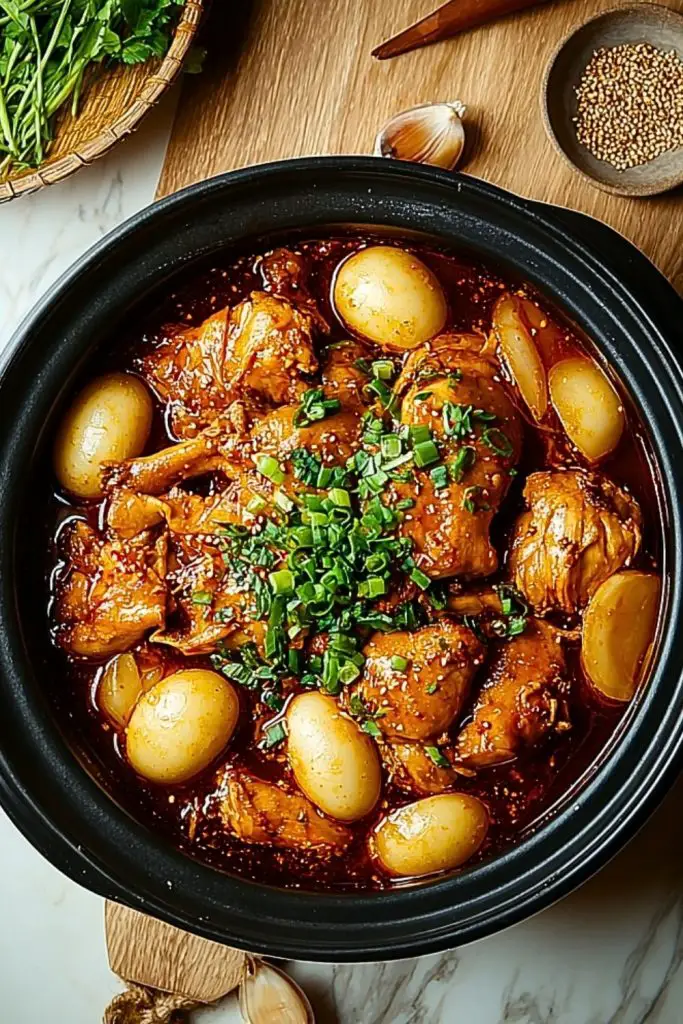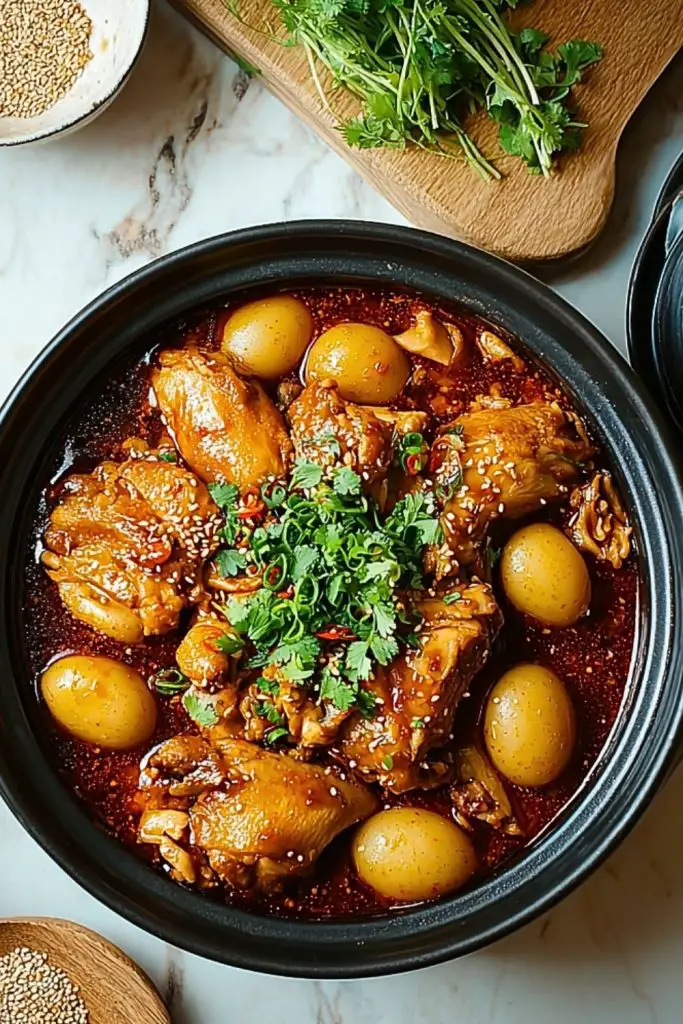Jjimdak, a beloved Korean braised chicken dish, is a rich, savory stew made with tender chicken pieces simmered in a flavorful soy-based sauce. Infused with garlic, ginger, onions, and a mild heat from Korean chilies, it’s balanced with the sweetness of vegetables and a glossy finish from sweet potato noodles. This comforting dish is traditionally enjoyed in large gatherings, served bubbling hot right at the center of the table.

What makes Jjimdak special isn’t just its depth of flavor but also its nourishing qualities. It’s packed with protein, hearty vegetables, and just the right amount of spice to awaken your taste buds. Whether it’s your first time making Korean food or you’re craving a cozy dinner with authentic flair, Jjimdak delivers a soulful and deeply satisfying experience.
Why You’ll Love This Jjimdak Korean Braised Chicken
This dish brings bold, authentic Korean flavors into your kitchen without requiring complicated techniques. It’s a one-pot meal that’s filling, deeply savory, and surprisingly easy to prepare. You’ll love how the chicken absorbs the umami-rich sauce, how the vegetables soak up the flavor, and how the sweet potato noodles bring a silky texture to every bite. Plus, it’s incredibly customizable—add more spice, swap veggies, or toss in glass noodles.
Preparation Phase & Tools to Use
To make Jjimdak successfully, a few key tools are essential:
- Heavy-bottomed pot or Dutch oven: Crucial for even heat distribution and long simmering without burning.
- Sharp knife: For cutting the chicken and vegetables cleanly and efficiently.
- Cutting board: A sturdy board helps speed up prep and ensures safety.
- Tongs or chopsticks: Useful for flipping chicken pieces and mixing ingredients.
- Measuring cups and spoons: Ensures you get the right balance of salty, sweet, and spicy.
Each of these tools supports the proper development of texture and flavor. The heavy pot, especially, helps retain heat and deepen the braise, which is essential for the signature depth of Jjimdak.
Preparation Tips
Start by soaking the sweet potato noodles in warm water while prepping your ingredients. This saves time and ensures they cook evenly later. Cut vegetables into large chunks—they’ll hold their shape better during braising. If you’re using bone-in chicken, give it a quick parboil before braising to remove impurities and keep the broth clean. Keep an eye on the heat; a gentle simmer is what you want, not a boil. Finally, always taste the sauce before the final simmer to adjust salt, sugar, or spice levels to your liking.
Ingredients for this Jjimdak Korean Braised Chicken
- 1 whole chicken (around 3 lbs), cut into bite-sized pieces
- 2 medium carrots, sliced into thick rounds
- 2 medium potatoes, peeled and cut into chunks
- 1 large onion, roughly chopped
- 1 cup Korean radish (mu), cut into thick pieces (optional)
- 8-10 garlic cloves, smashed
- 1-inch piece of ginger, sliced
- 3-4 dried Korean chilies (optional for mild heat)
- 1/3 cup soy sauce (preferably Korean Jin-ganjang)
- 2 tbsp dark soy sauce (for color)
- 2 tbsp brown sugar
- 1 tbsp honey (optional for extra sweetness)
- 1 tbsp mirin or rice wine
- 2 tsp sesame oil
- 1 tbsp oyster sauce (optional but recommended)
- 2 cups water or chicken stock
- 1 cup sweet potato noodles (dangmyeon), soaked for 30 mins in warm water
- 2 green onions, cut into 2-inch pieces
- 1 tbsp sesame seeds for garnish
- Fresh cilantro or parsley, chopped (optional garnish)
- Salt and pepper to taste

Step 1: Prep the Chicken and Soak the Noodles
Start by cutting the chicken into manageable, bite-sized pieces. If using bone-in pieces, briefly parboil them for 2–3 minutes in boiling water to remove excess fat and impurities. Meanwhile, soak the sweet potato noodles in warm water for 30 minutes until pliable.
Step 2: Prepare the Sauce Base
In a small mixing bowl, combine the soy sauce, dark soy sauce, brown sugar, honey, mirin, sesame oil, and oyster sauce. Stir well until everything is dissolved. This will be your braising sauce, packed with depth and umami.
Step 3: Start the Braising
Heat a heavy-bottomed pot or Dutch oven over medium-high heat. Add the chicken and stir-fry for a few minutes until it starts to turn golden. Add the garlic, ginger, and dried chilies. Pour in the sauce and add the 2 cups of water or chicken stock. Bring it to a boil, then reduce to a gentle simmer.
Step 4: Add Vegetables and Simmer
Add the carrots, potatoes, radish (if using), and chopped onions into the pot. Stir everything well so the sauce coats the ingredients. Simmer uncovered for about 20–25 minutes, or until the chicken is cooked through and the vegetables are fork-tender.
Step 5: Add the Noodles and Finish
Once the chicken and vegetables are tender, add the soaked dangmyeon (sweet potato noodles) and green onions to the pot. Let it simmer for another 5–7 minutes until the noodles absorb the sauce and soften completely. If the sauce is too thick, add a little more water or stock.
Step 6: Garnish and Serve
Turn off the heat and sprinkle sesame seeds and chopped cilantro or parsley over the dish. Serve hot directly from the pot or transfer to a serving platter. Jjimdak is best enjoyed with a side of steamed rice or kimchi.
Notes
Jjimdak is incredibly versatile—while the traditional version includes sweet potato noodles and a mix of root vegetables, you can adjust based on what you have on hand. The dish gets even better the next day as the flavors deepen, so don’t hesitate to make it ahead. When choosing chicken, bone-in pieces offer more flavor, but boneless thighs or breast can be used for convenience. Adjust sweetness and spice to taste, and feel free to throw in mushrooms, zucchini, or bell peppers for variety.
Watch Out for These Mistakes While Cooking
- Skipping the parboil step: Especially with bone-in chicken, skipping this may result in a cloudy or greasy broth.
- Overcooking the vegetables: Cut vegetables in large chunks so they hold their texture during the simmer.
- Not soaking noodles beforehand: Dangmyeon needs to be pre-soaked or it won’t cook evenly in the braise.
- Boiling instead of simmering: A hard boil can toughen chicken and break down vegetables too quickly.
- Using regular soy sauce only: Combining light and dark soy sauces adds richness and color.
Storage Instructions
Let the dish cool completely before storing. Transfer to an airtight container and refrigerate for up to 4 days. The flavor intensifies over time, making it a great make-ahead dish. For freezing, remove the noodles (they don’t freeze well) and store the chicken and broth separately in freezer-safe containers for up to 2 months. Reheat gently on the stove and add fresh noodles when serving.
Estimated Nutrition
Per serving (based on 4 servings):
- Calories: 520
- Protein: 35g
- Carbohydrates: 42g
- Fat: 22g
- Saturated Fat: 6g
- Cholesterol: 130mg
- Sodium: 850mg
- Sugar: 10g
- Fiber: 4g
Frequently Asked Questions
How spicy is Jjimdak?
It’s mildly spicy, especially with dried Korean chilies. You can make it completely non-spicy or add gochugaru or fresh chilies for extra heat.
Can I use boneless chicken?
Yes, boneless thighs or breast can be used. Reduce cooking time slightly to avoid drying out the meat.
What are sweet potato noodles?
Dangmyeon are Korean glass noodles made from sweet potato starch. They’re chewy, translucent, and perfect for soaking up sauces.
Can I make it vegetarian?
You can! Use tofu or mushrooms as the main protein and vegetable broth in place of chicken stock. Omit oyster sauce or use a plant-based alternative.
How do I make the sauce thicker?
Simmer uncovered a little longer to reduce the liquid. You can also mash a few potato chunks into the broth for natural thickening.
Is this dish gluten-free?
It can be if you use gluten-free soy sauce and ensure other sauces like oyster or mirin are gluten-free versions.
Can I prepare this in advance?
Absolutely. Jjimdak tastes even better the next day, so it’s perfect for meal prep or cooking ahead for guests.
What side dishes go well with Jjimdak?
Serve with steamed white rice, kimchi, pickled radish, or a light cucumber salad for balance.
Conclusion
Jjimdak Korean Braised Chicken is a dish that effortlessly combines comfort, tradition, and bold flavor in every bite. It’s simple enough for a weekday dinner yet impressive enough to serve guests. The combination of tender chicken, hearty vegetables, and umami-packed sauce makes this a go-to recipe for anyone craving wholesome Korean cuisine at home. Once you make it, it’ll earn a permanent place in your recipe rotation.

Jjimdak Korean Braised Chicken
- Total Time: 55 minutes
- Yield: 4 servings
Description
If you’re looking for a cozy, flavor-packed Korean dish that’s perfect for a hearty dinner or weekend treat, Jjimdak Korean Braised Chicken delivers big time. This comforting one-pot meal features juicy chicken, soft vegetables, chewy sweet potato noodles, and a rich soy-based sauce infused with garlic and ginger. It’s an easy recipe that brings authentic Korean flavors to your kitchen. Ideal for those searching for easy dinner ideas, authentic Korean recipes, or a quick comfort food fix that tastes like it simmered all day.
Ingredients
1 whole chicken (around 3 lbs), cut into bite-sized pieces
2 medium carrots, sliced into thick rounds
2 medium potatoes, peeled and cut into chunks
1 large onion, roughly chopped
1 cup Korean radish (mu), cut into thick pieces
8 garlic cloves, smashed
1 inch piece of ginger, sliced
3 dried Korean chilies
1/3 cup soy sauce
2 tablespoons dark soy sauce
2 tablespoons brown sugar
1 tablespoon honey
1 tablespoon mirin
2 teaspoons sesame oil
1 tablespoon oyster sauce
2 cups water or chicken stock
1 cup sweet potato noodles, soaked in warm water
2 green onions, cut into 2-inch pieces
1 tablespoon sesame seeds
Chopped cilantro or parsley
Salt and pepper to taste
Instructions
1. Cut chicken into bite-sized pieces and parboil briefly for 2–3 minutes. Soak sweet potato noodles in warm water for 30 minutes.
2. Mix soy sauce, dark soy sauce, brown sugar, honey, mirin, sesame oil, and oyster sauce in a small bowl.
3. Heat a heavy pot and add chicken. Stir-fry until lightly golden. Add garlic, ginger, dried chilies, then pour in sauce and water/stock. Bring to a boil.
4. Add carrots, potatoes, radish, and onion. Simmer uncovered for 20–25 minutes until chicken is tender and vegetables are cooked.
5. Add soaked noodles and green onions. Simmer for another 5–7 minutes until noodles are soft and have absorbed the sauce.
6. Garnish with sesame seeds and chopped herbs. Serve hot with steamed rice or kimchi.
Notes
For a cleaner broth, always parboil bone-in chicken before braising.
Don’t skip soaking the noodles—they need to be soft before going into the stew.
Large vegetable chunks keep their texture better during simmering.
- Prep Time: 20 minutes
- Cook Time: 35 minutes
- Category: Main Dish
- Method: Braised
- Cuisine: Korean
Nutrition
- Serving Size: 1 portion
- Calories: 520
- Sugar: 10g
- Sodium: 850mg
- Fat: 22g
- Saturated Fat: 6g
- Unsaturated Fat: 14g
- Trans Fat: 0g
- Carbohydrates: 42g
- Fiber: 4g
- Protein: 35g
- Cholesterol: 130mg
Keywords: jjimdak, korean chicken recipe, easy dinner, braised chicken, korean food ideas

